Lights Over lapland is excited to announce that Autumn Aurora Adventures are available for immediate booking! Reserve your adventure of a lifetime in Abisko National Park, Sweden today! | | |
GEOMAGNETIC STORM WATCH: Spewing a stream of solar wind as fast as 700 km/s (1.6 million mph), a hole in the sun's atmosphere is turning toward Earth. Forecasters expect the stream to reach our planet on June 15th or 16th with a 40% chance of minor G1-class geomagnetic storms when it arrives. High-latitude sky watchers should be alert for auroras in the nights ahead, especially in the southern hemisphere where deepening autumn darkness favors visibility. Free: Aurora Alerts
MYSTERY OF THE MISSING NOCTILUCENT CLOUDS: In late May 2017, observers in Europe began seeing electric-blue tendrils snaking over the western horizon at sunset. The summer season for noctilucent clouds (NLCs) was apparently beginning. Normally, the strange-looking clouds surge in visibility in the weeks immediately after their first sighting. This year, however, something mysterious happened. Instead of surging, the clouds vanished. During the first two weeks of June 2017, Spaceweather.com received ZERO images of NLCs -- something that hasn't happened in nearly 20 years.
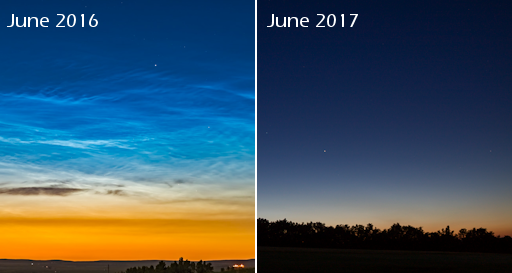
Where did they go? Researchers have just figured it out: There's been a "heat wave" in the polar mesosphere, a region in Earth's upper atmosphere where NLCs form. Relatively warm temperatures have wiped out the clouds.
Lynn Harvey of the University of Colorado's Laboratory for Atmospheric and Space Physics made the discovery using temperature data from the Microwave Limb Sounder onboard NASA's Aura satellite. "In early May, the summer mesosphere was cooling down as usual, approaching the low temperatures required for NLCs," she says. "But wouldn't you know it? Right after May 21st the temperature stopped cooling over the pole! In fact, it warmed a degree or two over the next week. The warming resulted in 2017 being the WARMEST summer mesopause in the last decade."
She is describing the red curve in this 10-year plot of polar mesospheric temperature trends:
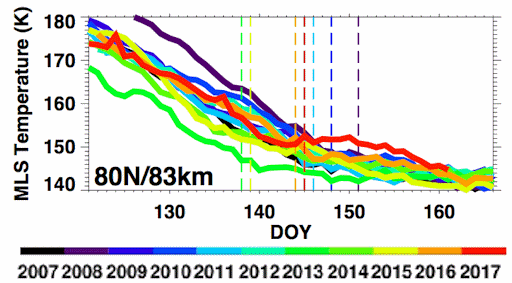
Warm temperatures are an anathema to NLCs. The icy clouds form 83 km above Earth when the air temperature drops below 145 K (-128 C), allowing scarce water molecules to get together and crystallize on specks of meteor smoke. Even a couple of degrees of warming is enough to obliterate the fragile clouds.
"We don't know why the mesosphere warmed up," says Cora Randall, Professor and Chair of the University of Colorado Department of Atmospheric and Oceanic Sciences. "It's probably a complex process involving the propagation of atmospheric gravity waves, which affect the flow of air and heat in the upper atmosphere. We're looking into it."
Meanwhile, the heat wave may be coming to an end. "In the last week, the north polar mesopause has started cooling again," says Harvey. This means NLCs should soon return, bouncing back to normal as temperatures drop. High latitude sky watchers should be alert for electric-tendrils creeping out of the sunset in the nights ahead--and if you see anything, submit your pictures here!
Realtime Noctilucent Cloud Photo Gallery
SPACE WEATHER BALLOON LAUNCH: A team of students from Earth to Sky Calculus and Spaceweather.com has arrived in Maine for a transcontinental space weather balloon launch. On June 15th and 16th, we'll be launching balloons simultaneously from California and New Hampshire:
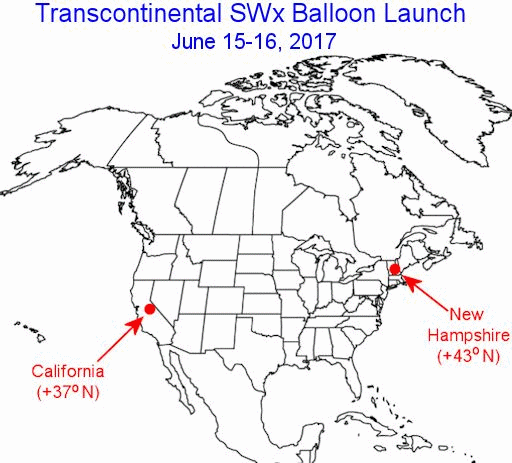
The purpose of this activity is two-fold:
1. We are training a team from the Southern Maine Community College to participate in our Solar Eclipse Balloon Network.
2. We will measure cosmic rays over both launch sites as part of our monitoring program of atmospheric radiation. Flying simultaneously, the balloons will ascend all the way to the stratosphere, sampling X-rays and gamma-rays at altitudes of interest to aviation, space tourism, and climate science. This is the 4th time since July 2015 that we've conducted this transcontinental experiment, and it is telling us some very interesting things about the variable shielding of Earth's magnetic field across North America.
Stay tuned for launch updates in the busy two days ahead.
Far Out Gifts: Earth to Sky Store
All proceeds support hands-on STEM education
SUNSET POLLEN CORONA: It's springtime and around the northern hemisphere the air is filling with pollen--a fine powdery substance discharged from the male parts of flowers and pine cones. Their mission is to fertilize parts of other plants. Along the way, they can also produce colorful displays in the sky like this one photographed last night by Matti Helin in Finland:
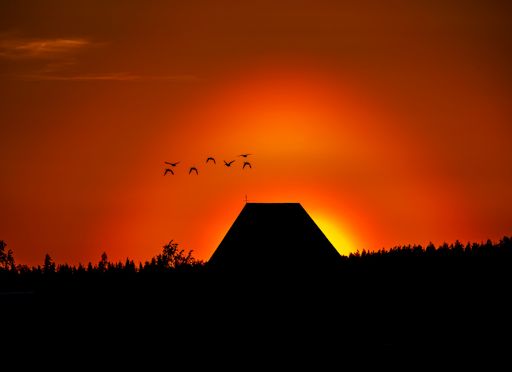
This is a "pollen corona" around the setting sun. Atmospheric optics expert Les Cowley explains: "Coronas are produced when light waves scatter from the outsides of small particles. Tiny droplets of water in clouds make most coronas, but pollen grains can do even better. They make small but very colorful multi-ringed coronas."
"Unlike water droplets, pollens are non-spherical--and this adds to their magic," he continues. "Many have air sacs to help carry them in the wind. These align the grains to give beautiful elliptical coronas with bright spots." The bright spots in Helin's pollen corona are caused by this effect.
As northern spring turns into summer, pollen coronas become increasingly common. Look for them in the realtime image gallery:
Realtime Space Weather Photo Gallery
Realtime Aurora Photo Gallery
Realtime Comet Photo Gallery
Every night, a network of
NASA all-sky cameras scans the skies above the United States for meteoritic fireballs. Automated software maintained by NASA's Meteoroid Environment Office calculates their orbits, velocity, penetration depth in Earth's atmosphere and many other characteristics. Daily results are presented here on Spaceweather.com.
On Jun. 15, 2017, the network reported 17 fireballs.
(17 sporadics)

In this diagram of the inner solar system, all of the fireball orbits intersect at a single point--Earth. The orbits are color-coded by velocity, from slow (red) to fast (blue). [Larger image] [movies]
Potentially Hazardous Asteroids (
PHAs) are space rocks larger than approximately 100m that can come closer to Earth than 0.05 AU. None of the known PHAs is on a collision course with our planet, although astronomers are finding
new ones all the time.
On June 15, 2017 there were 1803 potentially hazardous asteroids.
 |
Recent & Upcoming Earth-asteroid encounters: | Asteroid | Date(UT) | Miss Distance | Velocity (km/s) | Diameter (m) |
| 2017 HV4 | 2017-Jun-10 | 19.5 LD | 3.9 | 50 |
| 2017 KF3 | 2017-Jun-11 | 12.9 LD | 11.2 | 40 |
| 2010 VB1 | 2017-Jun-16 | 10.3 LD | 8.3 | 81 |
| 2017 LX | 2017-Jun-16 | 2.8 LD | 20 | 20 |
| 2017 LV | 2017-Jun-18 | 6.8 LD | 10.7 | 23 |
| 471984 | 2017-Jun-18 | 19.1 LD | 7.7 | 102 |
| 2017 LW | 2017-Jun-20 | 15.7 LD | 3.5 | 29 |
| 441987 | 2017-Jun-24 | 7.9 LD | 12.7 | 178 |
| 2017 BS5 | 2017-Jul-23 | 3.1 LD | 5.8 | 54 |
| 2014 OA339 | 2017-Aug-13 | 12.3 LD | 10 | 47 |
Notes: LD means "Lunar Distance." 1 LD = 384,401 km, the distance between Earth and the Moon. 1 LD also equals 0.00256 AU. MAG is the visual magnitude of the asteroid on the date of closest approach. | | Cosmic Rays in the Atmosphere |
Readers, thank you for your patience while we continue to develop this new section of Spaceweather.com. We've been working to streamline our data reduction, allowing us to post results from balloon flights much more rapidly, and we have developed a new data product, shown here:
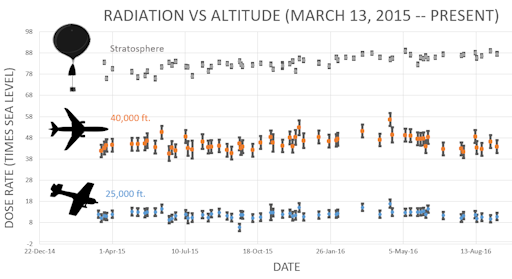
This plot displays radiation measurements not only in the stratosphere, but also at aviation altitudes. Dose rates are expessed as multiples of sea level. For instance, we see that boarding a plane that flies at 25,000 feet exposes passengers to dose rates ~10x higher than sea level. At 40,000 feet, the multiplier is closer to 50x. These measurements are made by our usual cosmic ray payload as it passes through aviation altitudes en route to the stratosphere over California.
What is this all about? Approximately once a week, Spaceweather.com and the students of Earth to Sky Calculus fly space weather balloons to the stratosphere over California. These balloons are equipped with radiation sensors that detect cosmic rays, a surprisingly "down to Earth" form of space weather. Cosmic rays can seed clouds, trigger lightning, and penetrate commercial airplanes. Furthermore, there are studies ( #1, #2, #3, #4) linking cosmic rays with cardiac arrhythmias and sudden cardiac death in the general population. Our latest measurements show that cosmic rays are intensifying, with an increase of more than 13% since 2015:
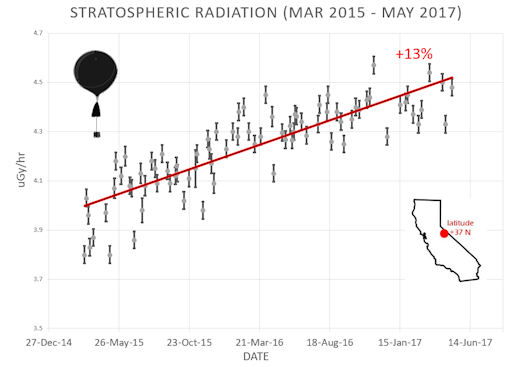
Why are cosmic rays intensifying? The main reason is the sun. Solar storm clouds such as coronal mass ejections (CMEs) sweep aside cosmic rays when they pass by Earth. During Solar Maximum, CMEs are abundant and cosmic rays are held at bay. Now, however, the solar cycle is swinging toward Solar Minimum, allowing cosmic rays to return. Another reason could be the weakening of Earth's magnetic field, which helps protect us from deep-space radiation.
The radiation sensors onboard our helium balloons detect X-rays and gamma-rays in the energy range 10 keV to 20 MeV. These energies span the range of medical X-ray machines and airport security scanners.
The data points in the graph above correspond to the peak of the Reneger-Pfotzer maximum, which lies about 67,000 feet above central California. When cosmic rays crash into Earth's atmosphere, they produce a spray of secondary particles that is most intense at the entrance to the stratosphere. Physicists Eric Reneger and Georg Pfotzer discovered the maximum using balloons in the 1930s and it is what we are measuring today.
| | The official U.S. government space weather bureau |
| | The first place to look for information about sundogs, pillars, rainbows and related phenomena. |
| | Researchers call it a "Hubble for the sun." SDO is the most advanced solar observatory ever. |
| | 3D views of the sun from NASA's Solar and Terrestrial Relations Observatory |
| | Realtime and archival images of the Sun from SOHO. |
| | from the NOAA Space Environment Center |
| | a proud supporter of science education and Spaceweather.com |
| | fun to read, but should be taken with a grain of salt! Forecasts looking ahead more than a few days are often wrong. |
| | from the NOAA Space Environment Center |
| | the underlying science of space weather |
 | Beautyz for top beauty products reviews and their buying guides |
 | Reviews here can help you to pick up best memory foam mattresses. |
| | These links help Spaceweather.com stay online. Thank you to our supporters! |
| | | | | | |

